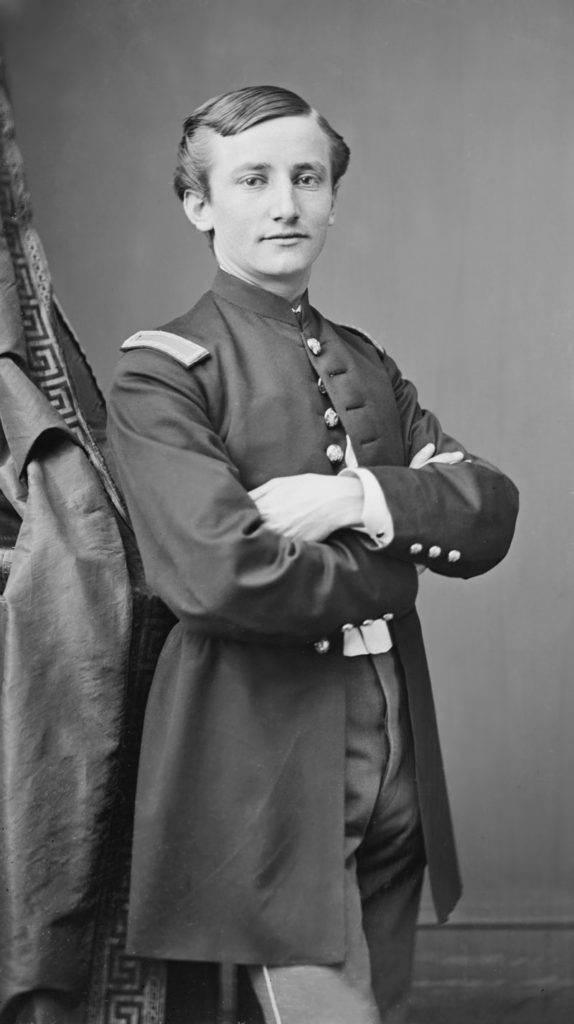Born on August 13, 1851, in Newark, Ohio, John Clem’s original surname was spelled “Klem,” but that’s not what makes him an unsung Civil War hero. John is considered by most historians to be the youngest decorated Civil War hero of them all, on either side of the war.
According to Clem himself, he ran away from home at age ten to join the Union army, shortly after his mother was killed in a train accident. In Clem’s version of the story, he first tried to join the 3rd Ohio Infantry, but they would not take him because he was so young and small. He tried to join the 22nd Michigan Infantry after that, and they also turned him away. However, he followed them, and they eventually “adopted” him as a mascot for their regiment, and gave him the position of the drummer boy. Officers in the regiment pitched in from their own pay to give him the standard soldier’s salary of $13 a month, and he was permitted to officially enlist two years later when he was twelve.

John Clem in 1867 (Wikipedia)
Historians who have looked into Clem’s version of his military history now say the first part of the story, about leaving home at ten years old and approaching the 3rd Ohio Infantry first is probably made up. However, the second part, about officially joining the 22nd Michigan when he was eleven or twelve, is undoubtedly true.
John Clem became a nationally known figure during the Civil War, due to his young age as a soldier. He was present with the 22nd Michigan at the Battle of Chickamauga. During the battle, he rode an artillery caisson to the front lines and shot a musket that had been trimmed to be small enough for him to use. Though the Union had to retreat, John shot and wounded a Confederate Colonel who demanded he surrender to him. After this battle, John was promoted to Sergeant and became the youngest noncommissioned officer to ever serve in the United States Army. He also received a medal for shooting the Confederate Colonel, making him the youngest decorated soldier, as well. After the battle, John became popularly known as the “Drummer Boy of Chickamauga.”
John was captured by Confederate cavalrymen in October of 1863 while serving in Georgia as a train guard. The Confederates took his US Army uniform, including his cap that had three bullet holes in it, which upset John more than being captured. He was not a prisoner for long, as he was part of a prisoner exchanged shortly afterward. However, during the brief time they had him, the Confederates used John’s national fame as propaganda for their own cause. They illustrated his extreme youth as an example of how hard up the North was for soldiers when they would allow children to join the army.
John went on to serve the Union in quite a few other Civil War battles, having been transferred to the Army of the Cumberland, where he became a mounted orderly. He was honorably discharged from the Army in September of 1864, having been wounded twice in combat, all before he was fourteen years old.
After the war, John went to high school and graduated in 1870. In 1871, he joined the National Guard and was elected commander/captain of the Washington Rifles, which was a Washington, D.C. National Guard militia unit.
He aimed to join the United States Military Academy, but he failed the entrance exam twice. However, US President Ulysses Grant appointed him as a Second Lieutenant in the Twenty-Fourth United States Infantry shortly after his second failed entrance exam. John was promoted to First Lieutenant in 1874. He went on to Artillery School, which he graduated from the next year, and was promoted to Captain seven years after that. When he was promoted to Captain, he transferred to the Quartermaster Department, where he stayed for the rest of his military career. As it turned out, the military was his career. John was promoted to Major in 1895.
John served the United States in the Army during the Spanish-American War, acting as a port depot quartermaster in Portland, Oregon, and as a department quartermaster at the Department of Columbia. He was part of the occupation of Puerto Rico and served as both depot and chief quartermaster in San Juan.
He was promoted again in 1901, this time to Lieutenant Colonel, and achieved a promotion to Colonel in 1903. He was the chief quartermaster at Fort Sam Houston in Texas for five years, from 1906 to 1911. On August 13, 1915, he reached the mandatory retirement age from the army at age sixty-four and was promoted to Brigadier General upon his retirement. At the time of John’s retirement, he was the last Civil War soldier still serving in the US Army.
John received one more promotion, to Major General, on the retired list in 1916.
After he retired from his lifelong career in the US Army, John moved to Washington, D.C. for a while, before moving to San Antonio, Texas. He died there on May 13, 1937, at eighty-five years old, and was buried in Arlington National Cemetery in Arlington County, Virginia.

John Clem in 1922 (Wikipedia)
While having such a remarkable Civil War and subsequent military career, John managed to meet and marry Anita Rosetta French in 1875. They had a long marriage and were happy together. Anita died in 1899, and John remarried in 1903 to Bessie Sullivan, a woman from San Antonio, Texas. Interestingly, Bessie was the daughter of a Confederate veteran, which prompted John to say he was the most united American alive.
John had one child with Anita, and two with Bessie. His only daughter, a child with Bessie, became a nun, and eventually Mother Superior of a convent she helped found in Reno, Nevada.
In addition to his service in the Civil War and US Army, John Clem was a member of the Military Order of the Loyal Legion of the United States, and the Military Order of Foreign Wars.






